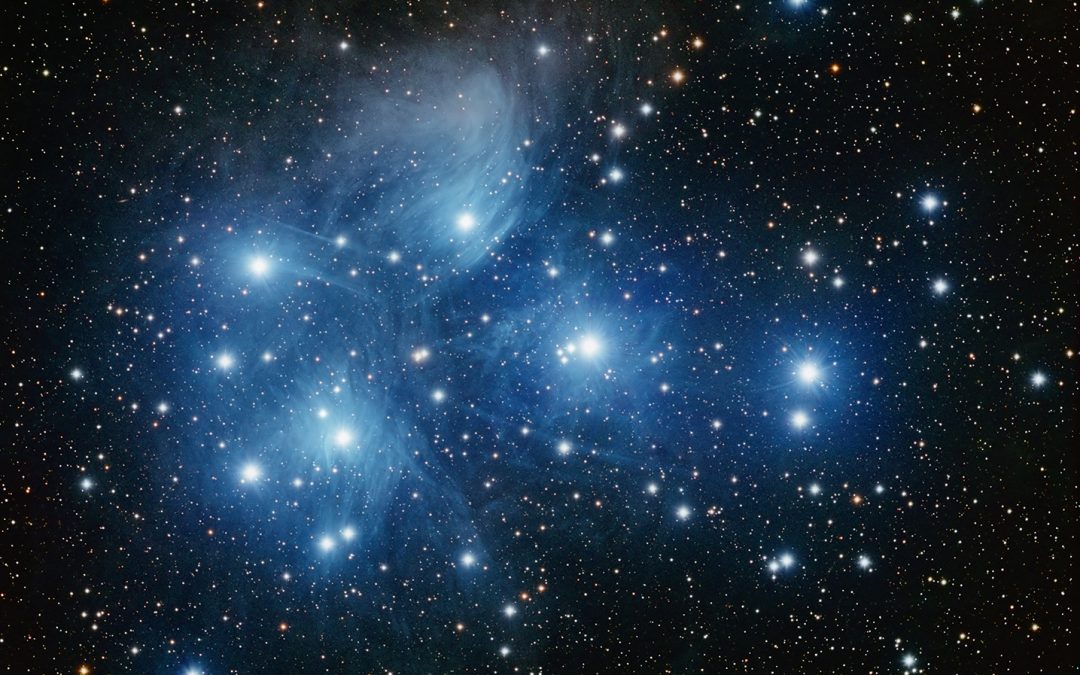above image credit: NASA
article by Ian Preece, Photographer-Astronomer, Kuaotunu
Although we exist under the same stars, it is not surprising perhaps that given the different cultures, lifestyles, and belief systems of the civilisations of Europe and Asia and the Pacific, we would evolve different understandings of the night sky and create different stories about their meaning and relevance.
Underlying these different stories however is a common view of theIr significance in determining critical aspects of our lives. The rising, passage and falling of stars and constellations through the year, often linked to the phases of the moon and the cycles of the sun, was commonly used to mark the passage of time and the seasons. Understanding when to sail, how to navigate, when to fish, when to plant and harvest was essential to the survival of our forebears.
Matariki being one of the most visible and notable markers in the night sky is a prime example of that. Its rising and falling with the sunrise linked to significant changes in the seasons.
Technically, It is an asterism, or pattern of stars, as well as an open star cluster that is visible in both the northern and southern hemispheres. It is made up of over 1000 stars and is 410 light years away and is estimated at between 75 to 150 million years old, which is quite young in terms of the universe. At a magnitude of 1.6, a measure of a star’s brightness, it is the brightest star cluster visible to the naked eye.
Known depictions of Matariki date back at least 17,500 years to the Lasaux Cave paintings in Southern France, drawn as Europe emerged from the last ice age. It also features on the Nebra Sky Disc, a bronze artefact from Germany created nearly 3,000 years ago.
Matariki has been known by many different names to many civilisations over time. It’s common Western name, the Pleaides, comes from Ancient Greek and refers to the daughters of Atlas and Pleione, the ocean nymph. Also known as the Seven Sisters, the name probably derives from plein, meaning”to sail”, because of the cluster’s importance in delimiting the sailing season in the Mediterranean Sea. It was also known to the Celts, Romans, Ancient Egyptians, Mesopotamians, Hindus, Chinese, Japanese, People of the Americas, and more.
Matariki is known across Polynesia with the same or commonly derived name. For example, Matariki in New Zealand, Easter Islands and the Cook Islands, Matalikiin in Tonga and Niue, and Matali’i in Tahiti. In Te Reo the meaning of this is “eyes of the god” or “eyes of the chief”.
In Te Ao Maori, the rising of Matariki just before the sun, known as its heliacal rising, marks the New Year. It is a time to mourn those who were lost and then to rest, celebrate and reflect and to look to the bounty of the New Year.
The stories that were crafted around the stars were drawn, in part, to remember, to recognise and to pass on this understanding in how the stars could be used to manage the web of life.
Matariki was also a navigational marker in the journey from Polynesia to Aotearoa. It could be argued that, without Matariki, we would not be here.
With the arrival of the Pakeha to New Zealand, knowledge of Maori astronomy was largely lost to view. There has been a recent resurgence of awareness in Maori astronomy leading to the introduction of Matariki as a New Zealand national holiday in 2022.
Noted astronomer, Dr Rangi Matamua, has been a leading figure in this resurgence. His book “Matariki: the Start of the Year” and a 4 part TV series “Beyond Matariki” are both excellent introductions and explainers of the significance of Matariki. Another good source is the book “Work of the Gods” by Kay Leather and Richard Hall. These texts have been invaluable sources as references for this article.
When and Where is Matariki?
The date for Matariki is calculated using the sun, moon and local conditions. This year it is the 29th June to 2nd July. The sun will rise at 7.30am at this time of year.
To help with recognising Matariki we can look at a number of night sky features from both Maori and Pakeha astronomy and how they compare.
These images were taken in Kuaotunu overlooking the Black Jacks last July around the time of Matariki which was 10th to 13th July in 2023.
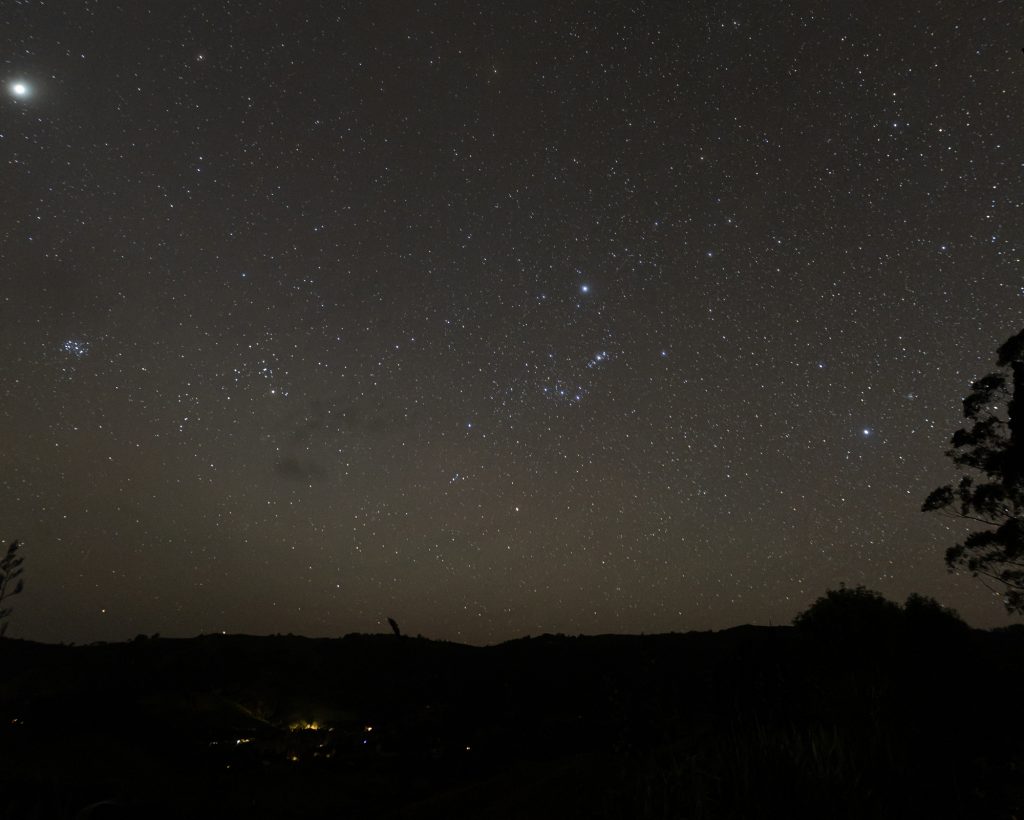
Figure 1
In this shot of the predawn night sky around Matariki several stars and star groups can be seen forming a near horizontal line.
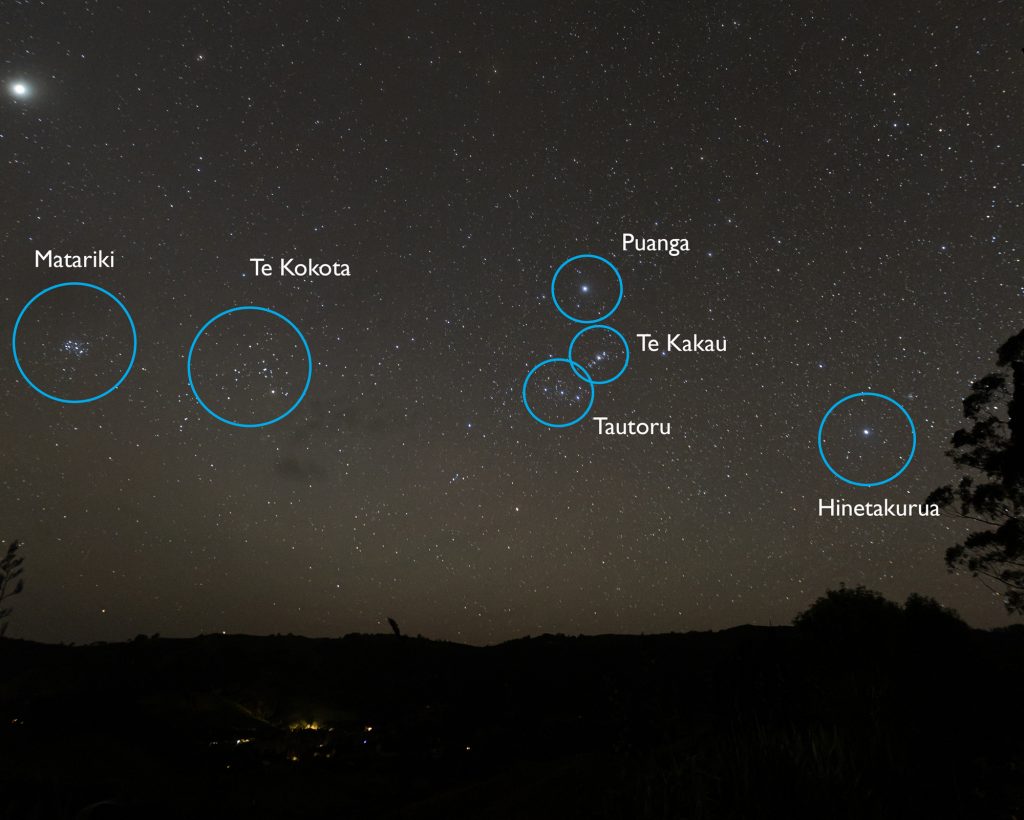
Figure 2
These are Matariki, Te Kokota to the right, Tautoro, Te Kakau, Puanga in the centre and Hinetakurua on the right hand side.
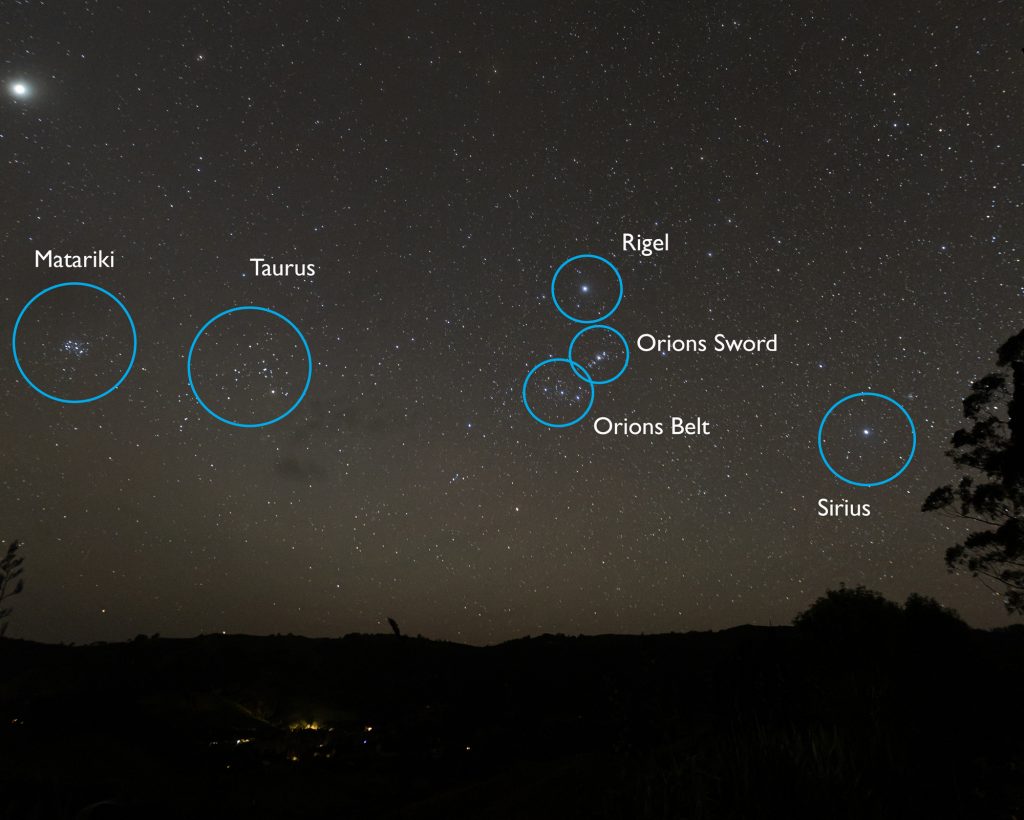
Figure 3
The prominence of these stars and patterns mean tthat they have been recognised by many cultures over the years. In European astronomy we have the Pleaides (Matariki) to the left of the picture, the head of Taurus next (Te Kokota which is the open cluster Hyades or the face of Taurus) and the dominant stars of Orion which are Orion’s Belt (Tautoro), Orion’s Sword (Te Kakau) and Rigel (Puanga). To the right we have Sirius (Hinetakurua) which is the brightest star in the sky and visible for most but not all of the year in New Zealand.
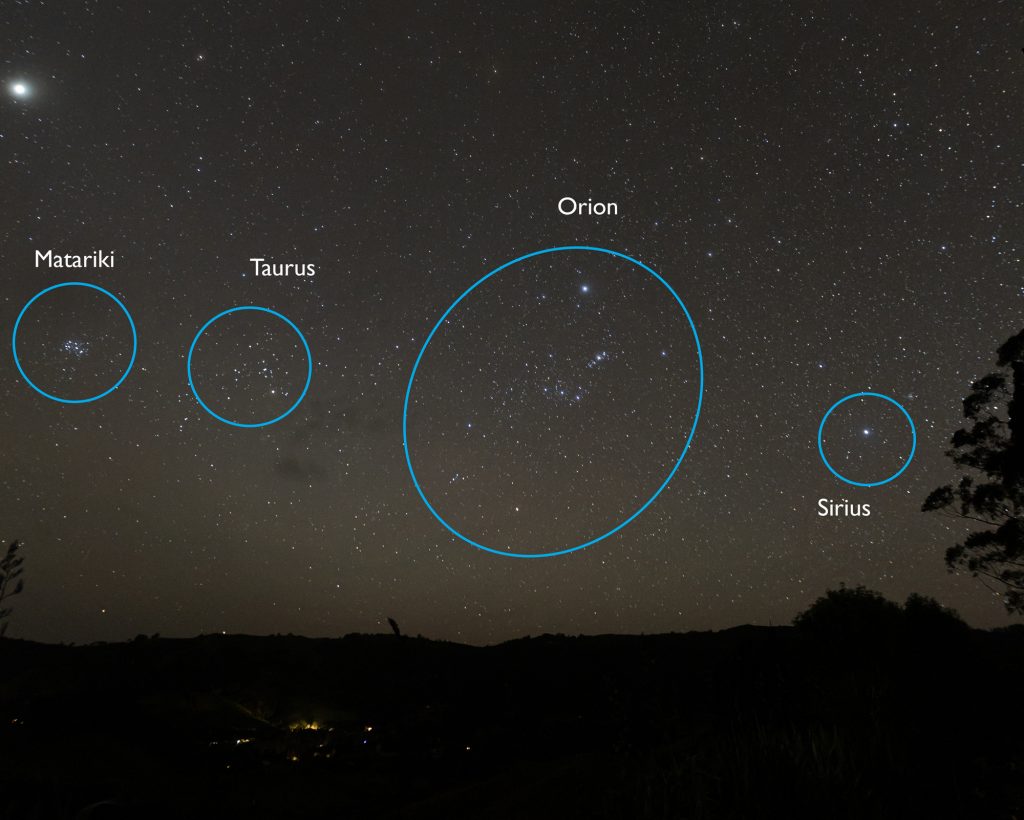
Figure 4
Orion is one of the most notable constellations in the night sky, it has several bright stars and the straight lines of the belt and the sword are easy to recognise. Once you spot these simply look to the left until you can see Matariki.
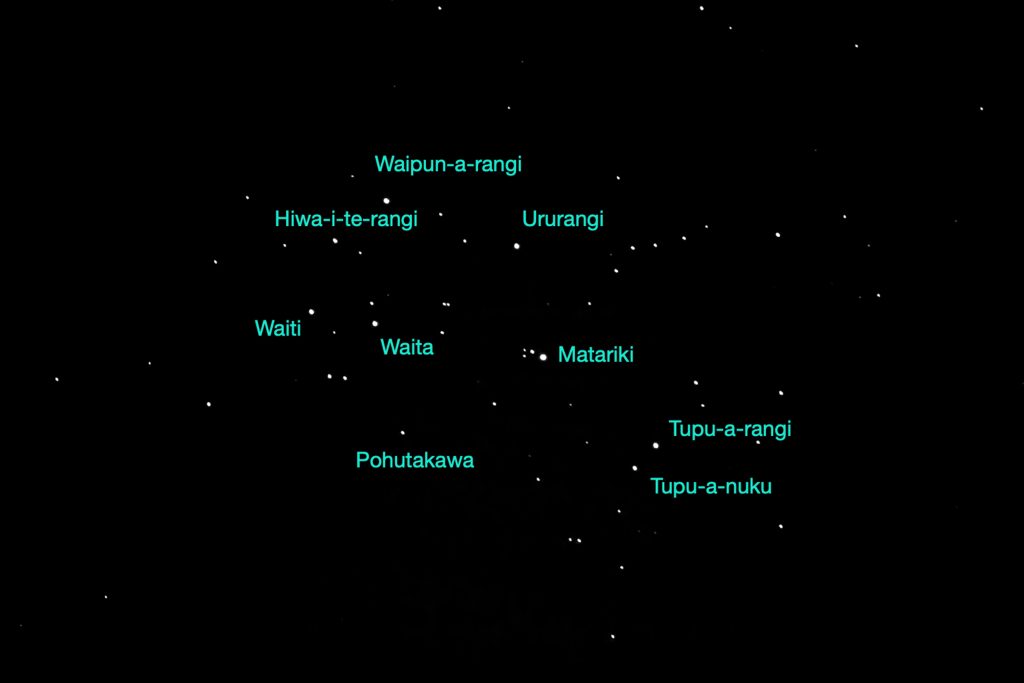
Figure 5
Looking closely we can see the individual stars that make up Matariki. There are 9 noted stars in Maori astronomy. In Europe it is 7. This photo shows over 100, as some cameras can see more than the human eye. Astronomers calculate there are in fact there over 1000.

Figure 6
This shot from NASA shows even more detail and the dust and gas clouds within the cluster.
8 Great Tips For Spotting Matariki:
If you do want to brave the cold, pre-dawn air to see the rise of Matariki then here are a few tips.
1.
The hour before sunrise when you will be heading out is the coldest part of the day so do keep warm. Gloves and hat always a good idea.
2.
Don’t go late as once the sun starts to rise you will miss it. Sunrise is around 7.30 am so head out to be on your spot from around 6am.
3.
Give your eyes 30 minutes to adjust to the darkness. When you do that, it is amazing how much more you will see.
4.
If you have binoculars take them along, you will see a lot more.
5.
Take a head torch to find your way about, but use it just to get to your spot then turn it off.
6.
Check your location during the day. Makes sure you have a good view due east. Looking directly out to sea is a good option, or being on top of a hill.
7.
Phone apps are very good to help spot stars – and also very good for messing up your night vision, so try not to use once you have your bearings.
8.
Clouds can come and go – so hang around.

